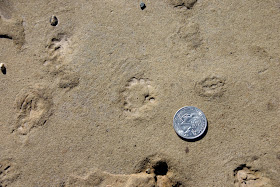The Fire Temple at Mesa Verde is an unusual cliff structure in that it is a large open plaza that was not a dwelling but may have served as an area for ceremonial dances and other communal activities. The whitewashed back wall bears painted clouds, animals, cactus, and humans. Fire Temple dates from 1250 AD, only a few decades before the Mesa Verde area was completely evacuated by the Ancestral Puebloans.
Fire Temple can best be seen from a stop on the popular Mesa Top auto tour route. However, just a short distance before the Fire Temple stop, is the Sun Point View pullout. From this stop one can get a panoramic view of a dozen cliff dwellings in the alcoves of Cliff and Fewkes Canyons. Of the millions of visitors who have stood here over the decades, few have ever looked down at the rocky surface they were standing on, except maybe to avoid tripping. Too bad for them.
Trace fossils are fossils resulting from organismal activities. Dinosaur footprints are a well known example. However, most trace fossils are formed by marine invertebrates living in and on ocean floor sediments. One of the more common fossil burrows goes by the scientific name Ophiomorpha. These are complicated burrows that run both vertically through sediments and along bedding planes within the sediments. The can run for several meters in length and have a distinctive pustulose or bumpy texture to the burrow walls. In today’s oceans Ophiomorpha-like burrows are made by callianassid shrimp. These shrimp press their own fecal pellets into the walls of the burrow, not only strengthening it, but giving it a distinctive bumpy texture. Given the great similarity between the modern burrows and Ophiomorpha fossils burrows, the inference is that the fossil burrows were also made by shrimp. Not necessarily callianassid shrimp but by shrimp with a similar burrowing lifestyle.
Remember that virtually all of the geology of Mesa Verde is made up of sediments laid down on the floor of Cretaceous seas that flooded the vast interior of North America. The broad and wide surface of the Sun Point View overlook is an exposed sandstone bedding surface of one of those seafloors. And it is rife with Ophiomorpha burrows. The red arrows in the photo above point to the most obvious of those burrows. They have been worn down by erosion, weathering, and foot traffic, but to the trained eye they stand out clearly.
The most obvious Ophiomorpha fossils are those burrows that run parallel to the bedding surface. They appear as tubes or grooves, some with the characteristic bumpy texture.
However, as we noted above, Opihomorpha burrows run both horizontally and vertically. Thus vertical tubes appear as circular structures on the bedding plane. They are about 1.5 -2.0 inches in diameter and show the characteristic texture. This can be best seen on some of the steps leading to the viewing area (see photo above). These circular fossils are sections through vertical parts of the burrow that run down to horizontal burrows still unexposed at a deeper levels.
So while 700+ years ago the Ancestral Puebloans danced their communal ceremonies on the plaza floor of Fire Temple, this rich deposit of extinct Ophiomorpha slept in its ancient sandstone tomb until centuries later it was exposed by modern man to form a place where people could gaze upon the architectural remains of that same extinct Puebloan culture. Ironic.
Photos: Dan Chure







No comments:
Post a Comment